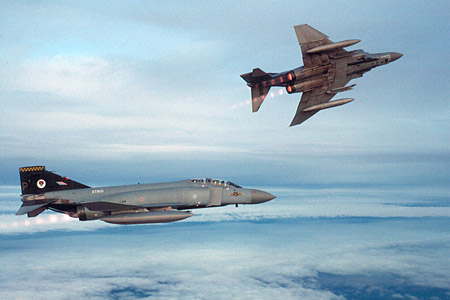Bob Archer remembers a trip of a lifetime
Since moving to Suffolk in the summer of 1966, I had visited RAF Wattisham many times - initially English Electric Lightnings were stationed there, followed by the mighty McDonnell F-4 Phantom. During the early 1990s, two famous squadrons were in residence, being 56 'Phoenix' and 74 'Tiger' Squadrons; these celebrated fighter units had achieved much success during the Second World War, and their lineage had been maintained subsequently. 74 Squadron's emblem was a Tiger's head, and as such was at the forefront of the formation of the 'Tiger Association'. This organisation was formed in 1961 when 74 Squadron, together with the American 79th Tactical Fighter Squadron flying the North American F-100 Super Sabre at RAF Woodbridge, met with the French Dassault Mystere IVAs of EC12 from Cambrai-Epinoy air base to exchange tactics. The week-long flying meet, staged at Woodbridge, was judged such a success that it has become an annual event, and expanded throughout NATO.
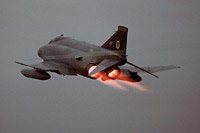 With
these credentials, 74 Squadron had justifiably become my favourite unit
in Royal Air Force service, and Wattisham one of my most beloved stations.
Therefore it is not difficult to appreciate my joy when journalist and
events organiser Peter March telephoned to ask if I would like a Phantom
flight. My immediate comment was "Now that is a silly question, do
I want a Phantom flight?" He qualified this by saying that RAF Strike
Command had cleared a Phantom orientation flight, and he was offering
it to me to prepare an article for the Royal Air Force Yearbook. He understood
my liking for 74 Squadron, and as the sortie was with that unit, he immediately
thought of me. He passed to me details of the sponsor, and I made contact.
The squadron suggested early November would be convenient, and maybe it
would be sensible to spend one day reviewing safety procedures and being
fitted with the flight suit, in preparation for the sortie the following
day.
With
these credentials, 74 Squadron had justifiably become my favourite unit
in Royal Air Force service, and Wattisham one of my most beloved stations.
Therefore it is not difficult to appreciate my joy when journalist and
events organiser Peter March telephoned to ask if I would like a Phantom
flight. My immediate comment was "Now that is a silly question, do
I want a Phantom flight?" He qualified this by saying that RAF Strike
Command had cleared a Phantom orientation flight, and he was offering
it to me to prepare an article for the Royal Air Force Yearbook. He understood
my liking for 74 Squadron, and as the sortie was with that unit, he immediately
thought of me. He passed to me details of the sponsor, and I made contact.
The squadron suggested early November would be convenient, and maybe it
would be sensible to spend one day reviewing safety procedures and being
fitted with the flight suit, in preparation for the sortie the following
day.
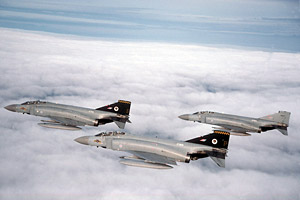 Wednesday
7 November 1991 was a dull, mild day, but I didn't care as I was off to
Wattisham to have fun with Phantoms and Phantom people. I bade farewell
to my wife and set off for the base. At the main gate I was met by my
host, and after the usual social pleasantries, taken to the 74 Squadron
complex. The entire Hardened Aircraft Shelter (HAS) complex and administrative
buildings were located within a circular area surrounded by a security
fence - there was a single road into the area, which had a guard post
at the entrance, although this was usually only manned during times of
crisis and exercises. There was also a taxiway leading in and out for
the aircraft to negotiate their way to either end of the runway. I was
ushered into the squadron operations area to
Wednesday
7 November 1991 was a dull, mild day, but I didn't care as I was off to
Wattisham to have fun with Phantoms and Phantom people. I bade farewell
to my wife and set off for the base. At the main gate I was met by my
host, and after the usual social pleasantries, taken to the 74 Squadron
complex. The entire Hardened Aircraft Shelter (HAS) complex and administrative
buildings were located within a circular area surrounded by a security
fence - there was a single road into the area, which had a guard post
at the entrance, although this was usually only manned during times of
crisis and exercises. There was also a taxiway leading in and out for
the aircraft to negotiate their way to either end of the runway. I was
ushered into the squadron operations area to 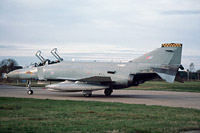 meet
Wing Commander Cliff Spink (who later rose to the lofty ranks as an Air
Marshal in the Royal Air Force) - many other officers and other ranks
were encountered during a very busy day that began with the endless rounds
of coffee in the aircrew 'lounge'. The first call was to the clothing
store to be kitted out - I was issued with a pair of white 'long johns',
a green flying suit coverall, and a pair of fairly new size-nine boots.
A brand new pair of cream gloves was unwrapped from their protective polythene
bag, which later became mine (the gloves not the bag)! Next came the G-suit,
consisting of a trouser-like garment resembling a pair of chaps worn by
cowboys - this had a zipper on the inside of both legs, and was designed
to fit snugly over the flying suit. The outfit was completed by a waistcoat
like upper body G-suit. Finally came the fitting of the helmet, known
universally as the 'bone dome'. To ensure it fitted with the minimum of
sideways movement, a pair of lanyards was tightened with the aid of a
small screwdriver. The process was now complete, and my entire flying
kit was stacked neatly on the counter of the clothing store.
meet
Wing Commander Cliff Spink (who later rose to the lofty ranks as an Air
Marshal in the Royal Air Force) - many other officers and other ranks
were encountered during a very busy day that began with the endless rounds
of coffee in the aircrew 'lounge'. The first call was to the clothing
store to be kitted out - I was issued with a pair of white 'long johns',
a green flying suit coverall, and a pair of fairly new size-nine boots.
A brand new pair of cream gloves was unwrapped from their protective polythene
bag, which later became mine (the gloves not the bag)! Next came the G-suit,
consisting of a trouser-like garment resembling a pair of chaps worn by
cowboys - this had a zipper on the inside of both legs, and was designed
to fit snugly over the flying suit. The outfit was completed by a waistcoat
like upper body G-suit. Finally came the fitting of the helmet, known
universally as the 'bone dome'. To ensure it fitted with the minimum of
sideways movement, a pair of lanyards was tightened with the aid of a
small screwdriver. The process was now complete, and my entire flying
kit was stacked neatly on the counter of the clothing store.
The next visit was to the base Medical Officer, who asked lots of pertinent questions, and carried some tests to ensure I was fit to fly. He also offered some practical advice concerning air sickness - a condition I had endured with various degrees of success and failure on all previous fast jet sorties. The safely briefing on egress in the event of an emergency was presented in video format, although one of my hosts was available to explain certain important points. The pre-flight process was completed, and I was taken to the main apron to familiarise myself with a Phantom rear cockpit, and to photograph some of the some aircraft parked after maintenance. The final duty of the day was to attend a briefing on the sortie, and to talk with the pilots so I would understand what was required of me during the flight, and also to make sure the photo opportunity would be beneficial.
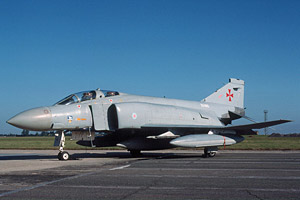 With
excitement tinged slightly with a little nervousness, I returned home,
and slept fitfully. I awoke early, and had an unhealthy breakfast, as
the station MO had advised I should eat something, as it would be better
in the event of my being airsick. I showed my pass at the main gate and
drove around to 74 Squadron. Coffee flowed, and it was soon time to don
the slightly uncomfortable flying suit. The plan was for a 14:45 takeoff
as a four-ship, and rendezvous with a Hercules tanker somewhere near Lowestoft.
We would observe the other three aircraft 'prodding' (taking on fuel),
then complete the rest of the sortie as a solo, before returning to Wattisham.
With
excitement tinged slightly with a little nervousness, I returned home,
and slept fitfully. I awoke early, and had an unhealthy breakfast, as
the station MO had advised I should eat something, as it would be better
in the event of my being airsick. I showed my pass at the main gate and
drove around to 74 Squadron. Coffee flowed, and it was soon time to don
the slightly uncomfortable flying suit. The plan was for a 14:45 takeoff
as a four-ship, and rendezvous with a Hercules tanker somewhere near Lowestoft.
We would observe the other three aircraft 'prodding' (taking on fuel),
then complete the rest of the sortie as a solo, before returning to Wattisham.
I was collected from the crew room by Flying Officer 'Hagar' Hargreaves, who was to be my pilot. In the operations 'nerve centre' Hagar checked that all was well with the flight plan, before adjourning to a small room for the pre-flight briefing. I was introduced to the other six crew members, and all manner of details were discussed, such as weather, frequencies, diversion airfields, and the sortie itself. With everyone happy with the plan, Hagar checked the Form 701 that details all maintenance issues with the aircraft, before signing his life away for the multi-million pound jet. It was then time to take the short walk in the welcoming fresh air to the hardened shelter. Inside was Phantom XV497, already connected to a ground power unit, producing a noticeable hum as it sent electrical life into all parts of the jet. Ground technicians were busy preparing the jet for flight, with each member coolly carrying out his duty with expert skill.
One of the
technicians assisted me into the rear cockpit, while Hagar performed the
traditional 'walk round', to ensure the aircraft was visually ready. He
then scrambled up the access ladder and settled into his 'office'. In
the meantime I had strapped into the ejector seat, and was shown which
safety pins to remove while taxing, and where to stow them. With helmet
in place, Hagar came up on the communications intercom to check I was
ready. He then performed a lot of pre-flight activities, before indicating
to one of the technicians that it was time to start engines. With one
of his fingers pointing skyward, he made a small circular movement, and
pressed a button for the start sequence to begin. The comparative peace
and tranquillity inside the shelter was shattered as the twenty-thousand
pounds of thrust from 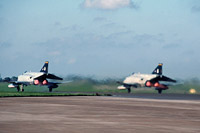 one
Rolls-Royce Spey spooled into life. With its systems functioning as advertised,
the second Spey was started. Hagar then gently eased the throttle forward
and the Phantom emerged from its concrete protection, just as the other
three pilots performed similar actions.
one
Rolls-Royce Spey spooled into life. With its systems functioning as advertised,
the second Spey was started. Hagar then gently eased the throttle forward
and the Phantom emerged from its concrete protection, just as the other
three pilots performed similar actions.
As the last aircraft of the four-ship formation, XV497 bounced along the taxiway and held short of runway 23. The first two aircraft taxied into position and with a discernable roar and clouds of black smoke form the engines, sat on the end of the runway. In perfect formation, the two pilots released their brakes, and the two Phantom front fuselages lifted slightly as afterburners were engaged. Four yellow balls of fire raced down the runway in a swirl of haze, before the two jets gained altitude and banked to the left. We then taxied onto the same spot, a large white '23' painted on the runway. With all four crew members acknowledging that they were happy, the control tower cleared us for take-off. Hagar and his wingman released their brakes in unison, and applied power. As the two jets accelerated forward, I briefly considered that Formula 1 racing car drivers must experience similar forces. The two aircraft, seemingly inches from one another, bounded down the runway, until both became airborne, and the effects of slicing smoothly through the air at low level over the brown fields of the Suffolk countryside could really be appreciated. We banked left too, and quickly joined up with the other pair of fighters. After a short period of close formation for photography, it was time to meet the Hercules tanker - the other three Phantoms began swarming around the 'mother-hen' Hercules, each awaiting its turn to 'prod' and take on fuel.
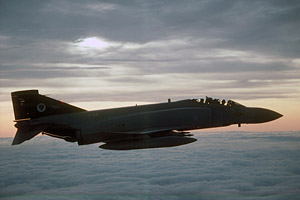 Earlier,
I had been apprehensive about the cloud base, as there was one layer at
low level and one at medium level. Our refuelling altitude was to be 6,000
feet, which seemed to offer photography in solid cloud… However, to my
delight and relief, the sun was low enough in the sky at that time of
day to be shining brightly on the four aircraft. Hagar was fantastic,
and placed XV497 in various ideal positions for photography, including
some lovely silhouette images of the Hercules connected to a Phantom.
Having replenished their tanks, but more importantly gained some valuable
aerial refuelling practice, the three Phantoms then proceeded on their
way to continue the sortie. Hagar made contact with the Hercules, and
was vectored to the rear to practice prodding. The first two attempts
were failures, and I was given a verbal rollicking for not having guided
him to snag the drogue! At the third attempt a successful connection was
made, and we took two thousand pounds of fuel. He then asked if I wanted
to do some aerobatics…with my track record for air sickness I politely
declined. Instead, I asked if it was possible to go through the sound
barrier - this met with humorous approval from Hagar, who contacted the
air defence control and reporting centre at RAF Neatishead in Norfolk.
The controller clearly understood the request for "permission to
do a fast run" and cleared Hagar to ten thousand feet on an easterly
heading over the North Sea, and responded with "Have fun!" At
the top of the climb, Hagar engaged the afterburners again, and aimed
the Phantom in a gentle dive - the acceleration could only be described
as phenomenal. A small speed indicator in the rear cockpit was spinning
round so fast, it almost seized solid!
Earlier,
I had been apprehensive about the cloud base, as there was one layer at
low level and one at medium level. Our refuelling altitude was to be 6,000
feet, which seemed to offer photography in solid cloud… However, to my
delight and relief, the sun was low enough in the sky at that time of
day to be shining brightly on the four aircraft. Hagar was fantastic,
and placed XV497 in various ideal positions for photography, including
some lovely silhouette images of the Hercules connected to a Phantom.
Having replenished their tanks, but more importantly gained some valuable
aerial refuelling practice, the three Phantoms then proceeded on their
way to continue the sortie. Hagar made contact with the Hercules, and
was vectored to the rear to practice prodding. The first two attempts
were failures, and I was given a verbal rollicking for not having guided
him to snag the drogue! At the third attempt a successful connection was
made, and we took two thousand pounds of fuel. He then asked if I wanted
to do some aerobatics…with my track record for air sickness I politely
declined. Instead, I asked if it was possible to go through the sound
barrier - this met with humorous approval from Hagar, who contacted the
air defence control and reporting centre at RAF Neatishead in Norfolk.
The controller clearly understood the request for "permission to
do a fast run" and cleared Hagar to ten thousand feet on an easterly
heading over the North Sea, and responded with "Have fun!" At
the top of the climb, Hagar engaged the afterburners again, and aimed
the Phantom in a gentle dive - the acceleration could only be described
as phenomenal. A small speed indicator in the rear cockpit was spinning
round so fast, it almost seized solid!  If
the feeling of speed was impressive during take off, this was nothing
compared to the experience unfolding, which can only be described as breathtaking.
In a matter of seconds the Phantom had passed though the fabled sound
barrier, and Hagar calmly announced we were at Mach 1.1. At two hundred
feet above the North Sea, the impression of speed was almost unimaginable,
as the Phantom rocketed above the waves, the moisture from the sea sending
vortices shooting skyward into the heavens. Hagar then suggested it might
be wise to return to sub-sonic speed, as the Netherlands was approaching
rapidly, and we were in danger of smashing every pane of glass within
the area of Rotterdam. While this seemed like a super wheeze at the time,
the thought of the RAF having a vast bill for window replacement brought
us back to reality, and the Phantom to a credible speed.
If
the feeling of speed was impressive during take off, this was nothing
compared to the experience unfolding, which can only be described as breathtaking.
In a matter of seconds the Phantom had passed though the fabled sound
barrier, and Hagar calmly announced we were at Mach 1.1. At two hundred
feet above the North Sea, the impression of speed was almost unimaginable,
as the Phantom rocketed above the waves, the moisture from the sea sending
vortices shooting skyward into the heavens. Hagar then suggested it might
be wise to return to sub-sonic speed, as the Netherlands was approaching
rapidly, and we were in danger of smashing every pane of glass within
the area of Rotterdam. While this seemed like a super wheeze at the time,
the thought of the RAF having a vast bill for window replacement brought
us back to reality, and the Phantom to a credible speed.
|
Tanking
trail
|
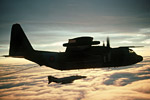 |
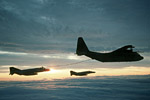 |
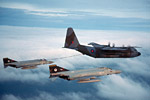 |
With the
sun almost on the horizon, Hagar turned the Phantom back onto a heading
to the UK, and both us settled down for the journey back to Wattisham.
A brief calculation of the fuel state suggested that the majority we took
from the Hercules had been used up in our ten-second sound barrier escapade!
However, there was sufficient to return safely to Wattisham, and with
an adequate reserve. Hagar then suggested we could give an impromptu air
show to some of the ferries transiting the North Sea! A few miles from
Felixstowe we encountered a large vessel heading west - at a safe distance,
and at the 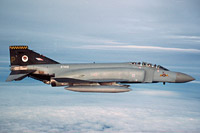 same
height as the ship's bridge, Hagar hauled the Phantom into a tight turn
across the bow, while briefly lighting the afterburner. With twilight
changing into darkness, the passengers must have been treated to a very
impressive spectacle. It was then time to return home - Hagar checked
with the tower, who approved a couple of overshoots for the benefit of
his passenger, before finally settling the Phantom gently onto the runway,
slowing almost to a stop to drop the brake chute. Both of us activated
the small lever to open the cockpit, and let precious, cooling fresh air
inside. I was advised to replace the pins as the Phantom followed the
taxiway to its shelter. Hagar halted the aircraft outside the open doors,
and conducted his post-flight checks as the engines wound down. With everything
back in its place I gingerly climbed down the ladder and felt the wonderful
feeling of terra firma.
same
height as the ship's bridge, Hagar hauled the Phantom into a tight turn
across the bow, while briefly lighting the afterburner. With twilight
changing into darkness, the passengers must have been treated to a very
impressive spectacle. It was then time to return home - Hagar checked
with the tower, who approved a couple of overshoots for the benefit of
his passenger, before finally settling the Phantom gently onto the runway,
slowing almost to a stop to drop the brake chute. Both of us activated
the small lever to open the cockpit, and let precious, cooling fresh air
inside. I was advised to replace the pins as the Phantom followed the
taxiway to its shelter. Hagar halted the aircraft outside the open doors,
and conducted his post-flight checks as the engines wound down. With everything
back in its place I gingerly climbed down the ladder and felt the wonderful
feeling of terra firma.
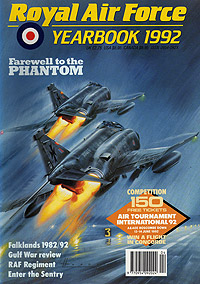 Halfway
through the flight I had started to get exceedingly hot, with sweat starting
to run down the inside of the helmet. While not actually being sick, I
had grabbed the sick bag on more than one occasion, just in case. Back
on the ground my legs felt like jelly, and my body was sensing I had just
gone twelve rounds with a heavyweight boxing champion! Despite these bodily
senses, there was a wide grin on my face, and a feeling that I had just
enjoyed something quite unforgettable, and an experience almost impossible
to recreate in civilian life. The opportunity for a civilian to fly in
a Phantom was something which was only offered to a very small number
of people each year - and today it had been me!
Halfway
through the flight I had started to get exceedingly hot, with sweat starting
to run down the inside of the helmet. While not actually being sick, I
had grabbed the sick bag on more than one occasion, just in case. Back
on the ground my legs felt like jelly, and my body was sensing I had just
gone twelve rounds with a heavyweight boxing champion! Despite these bodily
senses, there was a wide grin on my face, and a feeling that I had just
enjoyed something quite unforgettable, and an experience almost impossible
to recreate in civilian life. The opportunity for a civilian to fly in
a Phantom was something which was only offered to a very small number
of people each year - and today it had been me!
Hagar and I walked back to the squadron complex where he officially gave back the aircraft to the RAF. We then returned to the small room with the other pilots for a debrief, and with all these formalities complete, it was time for me to return the flying kit to the clothing store, and formally go back to be a mere civilian. It was also time to adjourn to the Mess for a welcome beer. While driving to the station earlier in the day, my car had begun to develop an electrical problem, and when I went to collect it from outside the mess, it failed to start. I telephoned my wife, who came out to the station to collect me. Throughout the journey home, I was babbling like an excited schoolboy, and I swear the grin did not leave my face for weeks.
